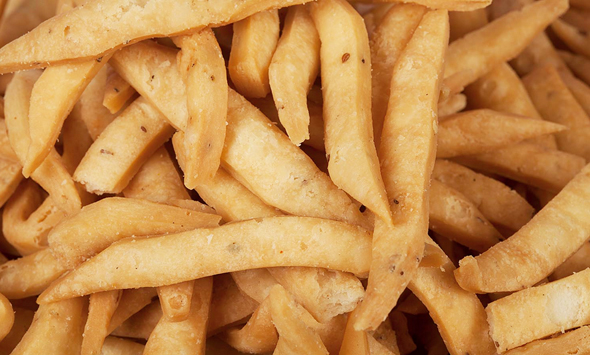Mama’s Punjabi Recipes
Namkeen Mutter or Namak Parre (Fried Salty Flour Sticks)
If you like matthis (fried crackers), then you’ll surely love namak pare (fried salty flour sticks) as they are made of one and the same ingredients but the results in savoring them are vastly different. This is a case where size does make the difference!! Unlike matthis, there are seldom variations using kali mirch (black peppercorns) or jeera (cumin seeds). But the texture makes all the difference.
Like matthis, there is usually a huge demand for namak parre during the winter months when people will eat them over hot tea, and people can go through a whole bag in one sitting! But the taste – and the enjoyment – depends on one secret ingredient – or should I say the absence of one ingredient: baking soda. This is used to produce carbon dioxide bubbles that rise at high temperatures and cause baked and fried items to become fluffier. The result is softer, less crispy foods, which is not what you want when you make matthis and namak parre!!
I did not believe this until we had a taste test between the namak parre made by one halwai close to our relatives’ house in West Delhi who uses baking soda and by another a few miles away who does not. The results were surprising to our relatives who quickly gobbled up the crispy, soda-free ones!
Just like matthis, you can make namak parre out of wheat flour at home. If you prefer using only maida (bleached white flour), just replace the atta with it in the recipe.ner, dipping it in some tomato ketchup! Hmmm! Delicious!!
Ingredients:
2 cup atta (whole wheat flour)
1 cup maida (bleached white flour)
1 cup tael (oil: sunflower or canola is best)
1 cup pani (warm water)
1 tsp namak (salt)
Tael (oil) to fry the dough inmirch (red pepper)
Directions:
1. In a large bowl, pour in the atta and the oil and mix well. Add the salt and knead the mixture with your hands.
2. Add some warm water to make the dough a little hard.
3. Take some dough and roll into a 2 inch ball. Flatten it with a rolling pin till it is round and about 1/4 inch thick.
4. Take a sharp edged knife and cut strips of the dough, about ½ inch wide. Then cut diagonally across to make 4 inch long pieces that resemble peas in pods: hence the name mutter (peas).
5. Continue to roll out the rest of the dough as you finish off each batch.
6. In a kadai or wok, warm some oil over medium heat. When warm, gently slip the cut pieces into the oil and fry till they are golden but not very brown.
7. Take out of the oil and let the mutter rest on some paper towels to soak up any excess oil.
8. Once the mutter have cooled down, you can store them in a container with a tight lid. They will keep for many weeks.
MAMA’S TIP OF THE WEEK
MAKE INDIAN SWEETS TASTIER WITH SOAKED, PEELED ALMONDS
Many people make Indian sweets at home using dry fruits, but most of them take a short-cut when it comes to adding dried fruits, especially almonds. Some people throw in the almonds whole and unpeeled; others will crush unpeeled ones and mix them into the halwa, pinnis or kheer. For those who know the difference, there is something lacking as you get the taste of raw nuts.
For a more refined taste, it is always better to either roast the unpeeled almonds, or better still, soak them in boiling water and then peeled and slice them into slivers. I personally prefer soaking them overnight as this makes the almonds much softer and adds more flavor to the sweets.
Shakuntla Malhotra is a skilled cook of Punjabi dishes made in the old-fashioned style that she learnt as a young woman in her ancestral home in Lyallpur, India before it became part of Pakistan after the Partition in 1947. People have often admired her cooking for its simplicity and taste that comes with each mouthful. Even in her mid-eighties, she continues to cook daily and agreed to share some of her delectable Punjabi recipes.


